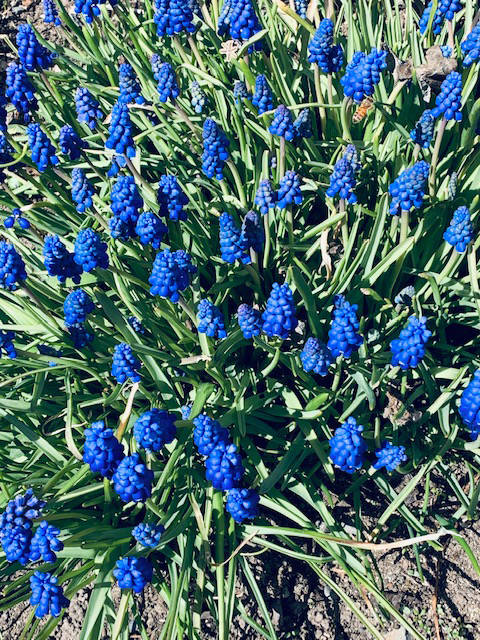Tall, sturdy fences, in the land of moose, are something to be grateful for. There is a new subdivision behind the high school that has successfully reduced urban moose habitat (and just as successfully will provide human habitat), pushing the ungulates west, thus into my neighborhood. There are two in the meadow in front of us at this very moment, intensively devouring cow parsnip. They could make quick work of this garden. But so far, today is not their lucky day.
My neighbor, Karen, has the black plastic edging that she wrestled out of the ground last year when she had some major dirt work done. Now the challenge is to return it to the ground. Better her than me. I really and truly believe that a sharp spade makes a lovely, functional edge and we should all be using that method. I like to get that task completed early in the year when the ground is soft and then again sometime mid season, or whenever it looks like it should be done.
Of course, depending on how much you have to edge, it really takes just a few minutes, once you have the edge established. My problem is that I plant too close to the edge and when the plants fill in they fall onto the grass, making mowing less effective. Ideally, we should be able to drop the lawn mower wheel into the little trench and mow along. But ideal anything is in short supply.
But I should back up. Do you know why you should be edging? Because grass is our most invasive plant (in my opinion). It will overtake your garden in jig time. So you can either spend an inordinate amount of time and effort pulling it out or you can stop it in its tracks with an edge. Really, why spend energy pulling grass? Go for a walk.
This is the perfect time to be moving plants. I have a nice stand of filipendula ulmeria on the north side of the house. Truly, this plant has been there for over 20 years, but it has moved itself right up against the boardwalk. This isn’t really a problem, but it looks uncomfortable. So, I dug it up and moved it back against the wall where there is already a sizable clump. Now they have company. What to do with the extra clump, because not only did I move it I downsized. Into the wheelbarrow and I trundled down the street looking for someone outside. Aha! Monica was in her driveway, a brief exchange of what to do with this plant, a little look around to find a spot for it, and I trundled home with an empty barrow. Excellent. Next on the list are the foxgloves that have seeded in the East Garden. They would be lovely on the south side so there they go. This will be the second year for Foxy foxglove. Although they bloom the first year, they will be gorgeous this year. I can hardly wait.
But transplanting can cause a plant to pause, to rethink its reason to be, to ponder if it really likes its new home or, perhaps, not. This is where fish emulsion comes in. I use a very dilute solution and water in the plant before tamping soil around its roots. I also do this with every seedling that goes into the ground. The emulsion is touted as mitigating transplant shock. It makes me feel like I’m doing something positive so I continue doing it.
Then this brings me to my spring feeding concoction. I got the recipe from Ann Lovejoy’s “Gardening From Scratch” and, naturally, it has morphed to suit my needs. Now that I have discovered alfalfa meal (one of the ingredients) my life is easier. I put a few shovelfuls of aged manure into the wheelbarrow, a few of compost, a sprinkling of wood ashes from the stove, and a shovelful of alfalfa meal, mix it all up and broadcast it on the vegetable beds and perennials. It does wonders. I had read that feeding perennials will make them too tall, if I were to cease and desist I wouldn’t need to stake. I tried that for two seasons and, really, was disappointed so I’m back to feeding. Give this some thought.
I have tried asparagus three times, buying huge healthy crowns. As each planting failed I would try again, putting them in a different place, hoping for the best. Doom. Last season I bought a four pack of teeny tiny asparagus seedlings from Baycrest Greenhouse. I scoffed at them, mocked them, bought them, stuck them in the ground with no expectation of success. ZOUNDS! They are gorgeous this year. Each plant has several spears albeit very thin. There will be no harvesting until they are 3 years old, so, if all goes well, I will be eating asparagus this time next year. Now THERE is something to look forward to.
The tomatoes are blooming in the greenhouse. We are eating lettuce and radish, both of which would be much happier outside, but, hey, a fresh salad is just the ticket right about now. I start four lettuce plants every 10 days and that ensures the two of us lettuce for the season. I already have seedlings planted outside. This way, nothing goes into the compost and it all gets gleefully consumed.
Do your best to not over plant; think about what you will eat and how much of it you need. The greenhouses are all accommodating our social distancing mandate and will have your order ready to go into your vehicle. The vegetable garden is completely planted, covered with floating row cover and waiting for that magic moment when the harvest begins. In the meantime there will be weeding, watering, cultivating, and enjoying the bird song. What better way to shelter in place?
Rosemary Fitzpatrick is a longtime Homer gardener and has been writing Kachemak Gardener since 1990.


